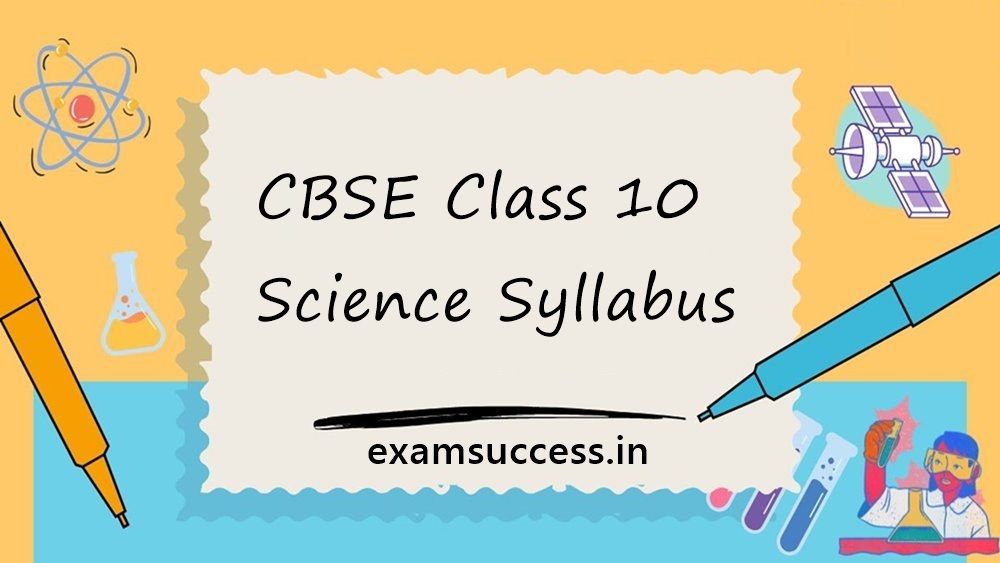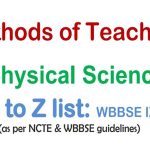CBSE Class 10 Science Syllabus: Unit-wise Weightage
| Unit No. | Title | Marks |
| I | Chemical Substances – Nature and Behaviour | 25 |
| II | World of Living | 25 |
| III | Natural Phenomena | 12 |
| IV | Effects of Current | 13 |
| V | Natural Resources | 5 |
| Total (Theory) | 80 | |
| Internal Assessment | 20 | |
| Grand Total | 100 |
Key Learning Areas
- Chemistry: Acids, bases, salts, metals & non-metals, carbon compounds, and types of chemical reactions.
- Biology: Life processes, reproduction, control and coordination, heredity, and evolution.
- Physics: Light reflection/refraction, electricity, magnetic effects of current, and optics.
- Environmental Science: Ecosystems, pollution, natural resources, and sustainable practices.
To check the detailed list of chapter-wise topics to be covered and prepared for the CBSE Class 10 Science Exam 2025-2026, view and download the syllabus below:
CBSE Class 10 Science Syllabus 2025-2026
Unit I: Chemical Substances – Nature and Behaviour
Theme: Materials (Weightage: 25 Marks)
Topics:
- Chemical Reactions and Equations
- Chemical reactions and equations
- Balanced chemical equation
- Types of chemical reactions:
- Combination
- Decomposition
- Displacement
- Double displacement
- Precipitation
- Endothermic and exothermic reactions
- Oxidation and reduction
- Acids, Bases and Salts
- Definitions (in terms of H⁺ and OH⁻ ions)
- Indicators
- Chemical properties and uses
- Neutralization
- Concept of pH scale (logarithmic explanation not required)
- Importance of pH in everyday life
- Preparation and uses of:
- Sodium Hydroxide (NaOH)
- Bleaching powder
- Baking soda
- Washing soda
- Plaster of Paris
- Metals and Non-metals
- Properties of metals and non-metals
- Reactivity series
- Formation and properties of ionic compounds
- Basic metallurgical processes
- Corrosion and its prevention
- Carbon and its Compounds
- Covalent bonds: Formation and properties
- Versatile nature of carbon
- Hydrocarbons: Saturated and unsaturated
- Homologous series
- Nomenclature of:
- Alkanes
- Alkenes
- Alkynes
- Carbon compounds with functional groups (halogens, alcohol, ketones, aldehydes)
- Chemical properties of carbon compounds:
- Combustion
- Oxidation
- Addition
- Substitution
- Ethanol and ethanoic acid (properties and uses)
- Soaps and detergents
Unit II: World of Living
Theme: The World of the Living (Weightage: 25 Marks)
Topics:
- Life Processes
- Characteristics of living beings
- Nutrition
- Respiration
- Transport
- Excretion (in plants and animals)
- Control and Coordination
- Tropic movements in plants
- Plant hormones (introduction)
- Nervous system in animals:
- Voluntary, involuntary, and reflex actions
- Chemical coordination: Animal hormones
- Reproduction
- Reproduction in animals and plants (asexual and sexual)
- Reproductive health
- Family planning: Needs and methods
- Safe sex vs. HIV/AIDS
- Childbearing and women’s health
- Heredity and Evolution
- Heredity and Mendel’s contribution
- Laws for inheritance of traits
- Sex determination (brief introduction)
Unit III: Natural Phenomena
Theme: Natural Phenomena (Weightage: 12 Marks)
Topics:
- Reflection of Light
- Curved surfaces (spherical mirrors)
- Images formed by spherical mirrors
- Centre of curvature, principal axis, focus, focal length
- Mirror formula (no derivation)
- Magnification
- Refraction of Light
- Laws of refraction
- Refractive index
- Refraction through spherical lenses
- Image formation
- Lens formula (no derivation)
- Magnification
- Power of a lens
- The Human Eye
- Working of the human eye
- Defects of vision and their correction
- Prism and Light Dispersion
- Refraction through a prism
- Dispersion of light
- Scattering of light
- Applications in daily life (excluding color of the sun at sunrise and sunset)
Unit IV: Effects of Current
Theme: How Things Work (Weightage: 13 Marks)
Topics:
- Electric Current
- Potential difference
- Ohm’s law
- Resistance and resistivity
- Factors affecting resistance
- Series and parallel combination of resistors
- Applications in daily life
- Heating Effect of Electric Current
- Applications in daily life
- Electric power
- Relationships between P, V, I, and R
- Magnetic Effects of Current
- Magnetic field and field lines
- Field due to:
- A current-carrying conductor
- A coil or solenoid
- Force on current-carrying conductor
- Fleming’s Left Hand Rule
- Direct and alternating current
- Frequency of AC
- Advantages of AC over DC
- Domestic electric circuits
Unit V: Natural Resources
Theme: Natural Resources (Weightage: 5 Marks)
Topics:
- Our Environment
- Ecosystem
- Environmental problems
- Ozone depletion
- Waste production and solutions
- Biodegradable and non-biodegradable substances
Read More:









